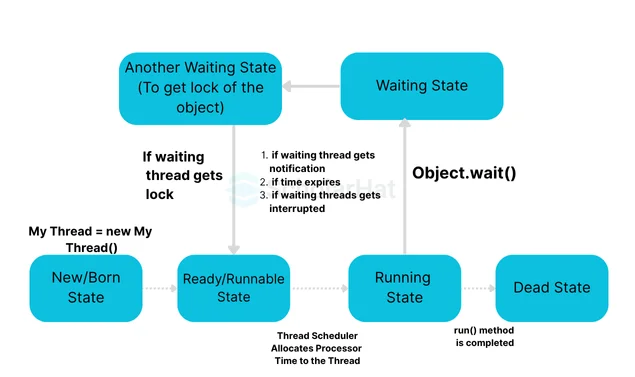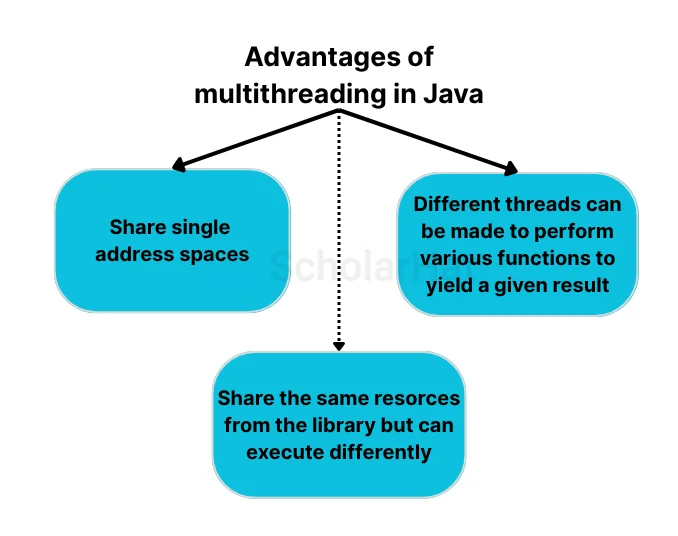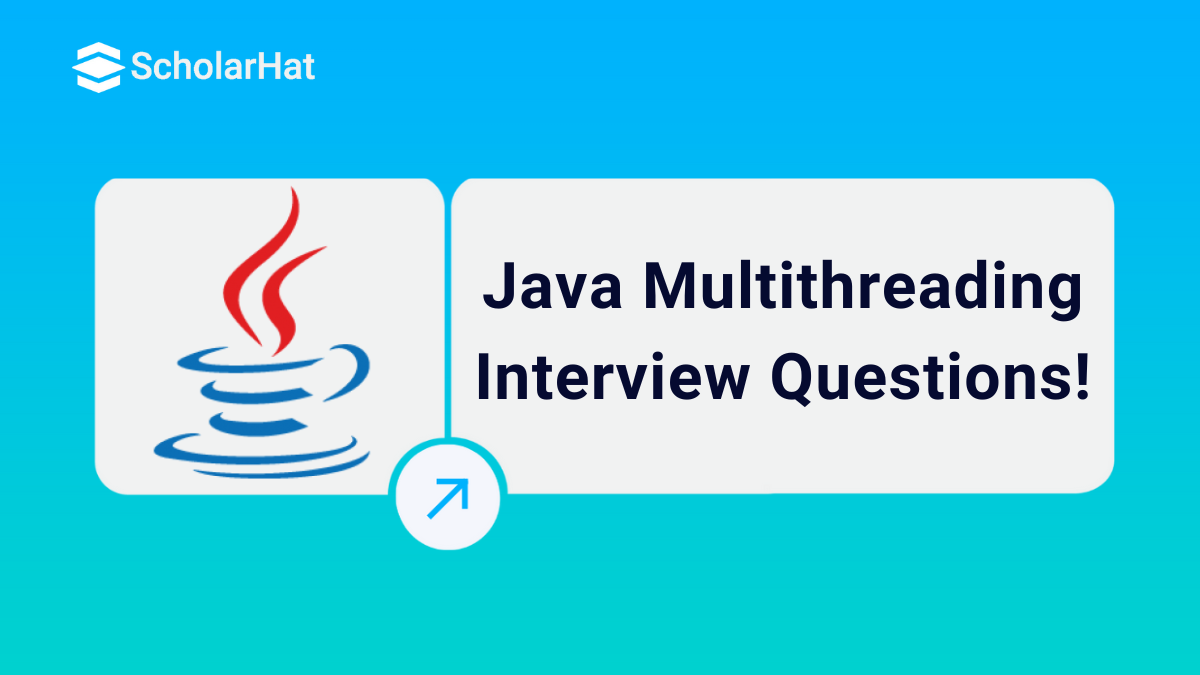29
DecJava Multithreading Interview Questions and Answers 2025
Multithreading Interview Questions
Are you preparing for a Java interview and want to master the most commonly asked Java Multithreading Interview Questions? You've landed on the right page!Multithreading is a crucial concept in Java, especially for roles involving backend development, performance optimization, and concurrency control. Recruiters often test your understanding of thread lifecycle, synchronization, thread safety, and Java Concurrency API — and being well-prepared can give you a serious edge.
In this blog, we’ve compiled the most frequently asked Java multithreading questions and answers, ranging from beginner to advanced levels. Each answer is written clearly and concisely to help you crack technical interviews with confidence. Only 5% of Java beginners unlock high-paying roles without proper guidance. Don’t miss out—Enroll now in our Free Java Course to kickstart your career with expert-led training.
Java Multithreading Interview Questions for Freshers
1. What is multithreading?
It is a process of concurrently executing multiple threads or parts of a program. Multithreading is used for multitasking purposes. It acquires less memory and provides fast and efficient performance.
2. What is the thread?
A thread is nothing but a lightweight subprocess. It is a different path of execution. Every thread runs in a different stack frame. The process can contain multiple threads. Every thread shares the same memory space.
3. Differentiate between process and thread.
| Process | Thread |
| A program in execution is a process | Thread is a part of a process |
| Processes are heavyweight | Threads are lightweight |
| Termination is slow | Termination is fast |
| Creation takes time | Creation takes less time |
| Communication between processes needs more time | Communication between threads requires less time |
| More time for context-switching | Less time for context-switching |
| Processes do not share memory | Threads share memory |
| Consumes more resources | Consumes lesser resources |
4. What is inter-thread communication?
- Inter-thread communication is nothing but the process of communication between synchronized threads.
- It is used to avoid thread polling in Java.
- The thread is paused running in its critical section, and another thread is allowed to enter the same critical section to be executed.
- inter-thread communication can be achieved by wait(), notify(), and notifyAll() methods.

5. Explain wait() method in Java? Why must it be called from the synchronized block?
It is the method provided by the Object class in Java. It is used for inter-thread communication in Java. java. lang.Object. wait() method is used to pause the current thread and wait until another thread does not call the notify() or notifyAll() method.
Syntax
public final void wait()We have to call the wait() method otherwise it will throw java.lang.IllegalMonitorStateException type exception. Because of this, we need the wait() method for inter-thread communication with notify() and notifyAll() methods.
6. How will you synchronize a method in Java?
We can use the synchronized modifier in the method's signature or use the synchronized {} construct inside the method.
Example
public void swap()
{
synchronized (this)
{
//Code
}
}
public synchronized void swap1EqualsSwap()
{
//Code
}
public static synchronized void swap2()
{
//Code
}
public static void swap3EqualsSwap2()
{
synchronized (JoinClass.class)
{
//Code
}
}
7. What are the advantages of multithreading?
- Improved Performance: Multithreaded programs can use multi-core processors, making them faster and more efficient.
- Enhanced Responsiveness: Multithreading allows for responsive user interfaces (UIs) in applications. Long-running tasks can be moved to background threads, ensuring the UI remains responsive to user input.
- Resource Utilization: Multithreading enables better utilization of system resources, as different threads can execute different tasks simultaneously.
- Parallel Processing: Multithreading is essential for parallel processing, where a large task is divided into smaller sub-tasks that can be executed concurrently, reducing overall execution time.

8. Discuss the states in the lifecycle of a Thread.
- New: A Thread class object is created using a new operator, but the thread is not alive. The thread doesn't start until we call the start() method.
- Runnable: The thread is run after calling the start() method. It is waiting in the ready or runnable queue to be allocated to the processor.
- Running: In this state, the thread scheduler picks the thread from the ready state and the thread executes.
- Waiting/Blocked: In this state, a thread is not running but still alive, or waiting for the other thread to finish.
- Dead/Terminated: The thread exits or stops executing due to some unusual happenings.
9. Explain the difference between preemptive scheduling and time slicing.
In preemptive scheduling, the highest priority task executes until it enters the waiting or dead state or a higher priority task comes into existence. On the other hand, in time slicing, a task executes for a predefined slice of time and then reenters the pool of ready tasks. Then the scheduler determines which task should execute next, based on priority and other factors.
| Join ScholarHat’s Java Full-Stack program and start coding like a pro. | |
| Training Name | Price |
| Full-Stack Java Developer Course (Become Job-Ready with ₹3 - ₹9 LPA* Opportunities) | Book a FREE Live Demo! |
10. What is context switching?
Context Switching is the process/method used by the system to change the process from one state to another using the CPUs present in the system to perform its job. It allows a single CPU to handle multiple process requests parallelly without the need for any additional processors.
11. Differentiate between the Thread class and Runnable interface for creating a thread.
- The thread can be created by extending the Thread class
- The thread can be created by implementing the Runnable interface
| Thread Class | Runnable Interface |
| It has multiple methods like start() and run() | It has only abstract method run() |
| Each thread creates a unique object and gets associated with it | Multiple threads share the same objects |
| More memory required | Less memory required |
| Multiple Inheritance is not allowed in Java hence after a class extends the Thread class, it can not extend any other class | If a class implements the runnable interface, it can extend another class. |
12. What is join() method?
One thread can call the join() method on another thread. As a result, the first thread that called the method suspends its work and waits for the second thread to finish execution.
The Thread class has three forms of join() method:
- public final void join() throws InterruptedException
- public final void join(long millis) throws InterruptedException
- public final void join(long millis, int nanos) throws InterruptedException
13. Describe the purpose and working of the sleep() method.
sleep() method in Java blocks a thread for a particular time, which means it pauses the execution of a thread for a specific time. There are two overloaded forms of sleep() method in java.lang.Thread class.
- public static void sleep(long millis) throws InterruptedException
- public static void sleep(long millis, int nanos) throws InterruptedException
Example Illustrating the Working of sleep() method
public class ThreadsInJava
{
public static void main(String[] args)
{
System.out.println("Before Sleeping");
try
{
Thread.sleep(50);
}
catch (InterruptedException e)
{
e.printStackTrace();
}
System.out.println("After Sleeping");
}
}
Thread.sleep(50) pauses the execution of the current thread for 50 milliseconds.
Output
Before Sleeping
After Sleeping
14. List out the differences between wait() and sleep() method.
| wait() | sleep() |
| wait() is a method of Object class | sleep() is a method of Thread class |
| wait() releases lock during synchronization | sleep() method does not release the lock on the object during synchronization |
| wait() is not a static method. | sleep() is a static method |
wait() has three overloaded methods:
| sleep() has two overloaded methods:
|
15.Can we call the run() method instead of start()?
- Yes, calling the run() method directly is valid, but it will not work as a thread instead it will work as a normal object.
- There is no context-switching between the threads.
- When we call the start() method, it internally calls the run() method. It creates a new stack for a thread while directly calling the run() will not create a new stack.
16. Explain daemon threads.
- JVM creates daemon threads.
- They are the low-priority threads that provide the background support and services to the user threads.
- JVM will not wait for these threads to finish their execution. JVM will exit as soon as all user threads finish their execution.
- There are two methods for daemon thread available in the Thread class:
- public void setDaemon(boolean status) marks the thread as a daemon or a user thread.
- public boolean daemon () checks whether the thread is a daemon.
17. What are the two ways of implementing thread in Java?
1. Extending the Thread class
Example
class MultithreadingDemo extends Thread
{
public void run()
{
System.out.println("Welcome to Scholarhat.");
}
public static void main(String args[])
{
MultithreadingDemo obj=new MultithreadingDemo();
obj.start();
}
}
Output
Welcome to Scholarhat. 2. Implementing Runnable interface in Java
Example
class MultithreadingDemo implements Runnable
{
public void run()
{
System.out.println("Welcome to Scholarhat..");
}
public static void main(String args[])
{
MultithreadingDemo obj=new MultithreadingDemo();
Threadtobj =new Thread(obj); tobj.start();
}
}
Output
Welcome to Scholarhat. 18.What’s the difference between notify() and notifyAll()?
1.notify()
- It sends a notification and wakes up only a single thread instead of multiple threads that are waiting on the object’s monitor.
- The notify() method is defined in the Object class, which is Java’s top-level class.
- It’s used to wake up only one thread that’s waiting for an object, and that thread then begins execution.
- The thread class notify() method is used to wake up a single thread.
2.notifyAll()
- It sends notifications wakes up all threads and allows them to compete for the object's monitor instead of a single thread.
- The notifyAll() wakes up all threads that are waiting on this object’s monitor.
- A thread waits on an object’s monitor by calling one of the wait methods.
- The awakened threads will not be able to proceed until the current thread relinquishes the lock on this object.
19. What is the default priority of a thread? Can we change it?
The default priority of a thread is the same as that of its parent. Yes, we can change the priority of a thread at any time using the setPriority() method.
Example
public class ThreadPriority
{
public static void main(String[] args)
{
Thread t = Thread.currentThread();
System.out.println(t.getPriority());
t.setPriority(8);
System.out.println(t.getPriority());
}
}
t.setPriority(8) sets the current thread priority to 8. By default, the priority of the main thread is Thread.NORM_PRIORITY, which is generally 5. This value is printed to the console.
Output
5
8 20. Is it possible to make constructors synchronized in Java?
No, the synchronized keyword cannot be used with constructors in Java. The synchronization mechanism in Java is designed to manage access to objects that already exist, ensuring that multiple threads do not interfere with each other when accessing a shared resource.
Java Multithreading Interview Questions for Intermediates
21. How interrupted() is different from isInterrupted() method in Java
| interrupted() | isInterrupted() |
| interrupted() is a static method of the Thread class | isInterrupted() is an instance method of the Thread class |
| interrupted() clears the interrupted status of the current thread | isInterrupted() method does not clear the interrupted status |
| operates on the currently executing thread | can be invoked on any Thread instance |
| It resets the interrupted status to false | isInterrupted() does not affect the interrupted status |
| can be invoked without a thread reference | requires a thread reference to invoke |
| checks the interrupted status of the current thread | checks the interrupted status of a specific thread |
22. Can we call start() method twice?
No, we can call the start() method only once. If you call the start() method a second time, it will throw an IllegalThreadStateException as the thread has already started.
23. What is a ThreadGroup?
ThreadGroup is a set of threads that can also contain other groups of threads. A group of threads forms a tree in which every other group of threads has a parent (except the original one). A thread has the right to access data from its thread group but does not have such access to other groups or the parent group of threads.
24. Describe the race condition.
A race condition occurs when multiple concurrent threads compete to run first. If the thread that wins the race isn't the one that was supposed to run first, the code may exhibit unexpected behavior. Synchronization can resolve this issue.
25. What are the common problems faced while working with threads in Java?
- Race Conditions: Thread interference leads to unexpected outcomes due to shared data access.
- Deadlocks: Circular waiting of threads for resources, causing a standstill in execution.
- Starvation: Unequal thread priority leads to some threads being consistently deprived of resources.
- Thread Synchronization Issues: Inconsistent synchronization of threads causes unpredictable behavior.
- Thread Safety Challenges: Ensuring data integrity across multiple threads can be complex.
- Performance Overheads: Context switching and synchronization mechanisms may impact system performance.
- Difficulty in Debugging: Identifying and rectifying thread-related issues can be difficult due to their asynchronous nature.
- Complexity in Coordination: Coordinating multiple threads for efficient execution requires careful design.
- Non-deterministic Execution: It can be difficult to predict the order of thread execution, leading to potential issues.
- Resource Contention: Threads competing for shared resources, causing delays and inefficiencies.
26. What are thread-local variables in Java?
Thread-local variables in Java are variables local to each thread i.e. each thread has its own copy. These variables are declared with the ThreadLocal class. This helps in avoiding interference between threads by providing isolated data storage.
27. What is a monitor?
The monitor is a body of code that can be executed by only one thread at a time.If any other thread attempts to get access at the same time, it will be suspended until the current thread releases the Monitor. Monitor monitors the access control of shared resources and objects among threads. Using this construct only one thread at a time gets access control over the critical section at the resource.
28. What do you understand about Deadlock situations in Java Multithreading?
Deadlock is a situation where each thread is waiting for resources held by other waiting threads. Due to this situation, no threads are executed, causing a pause in program execution and breaking the code at runtime.
29. How do you detect deadlock situations in Java? How can they be avoided?
Deadlock situations can be detected by running the executable code on cmd and subsequently collecting the thread dump. If deadlock situations are present, the cmd will throw up a message on cmd.
To avoid deadlock situations in Java:
- Avoid Nested Lock: This may create a deadlock if another thread wants the same lock currently held by this thread. Use lock ordering if you need nested synchronized blocks.
- Avoid unnecessary locks: Specify the time for a thread to acquire the lock. It is called lock timeout. Lock the code where it is needed.
30. Why is thread behavior unpredictable?
This is because the execution of threads depends on the thread scheduler. One should remember that every thread scheduler has a different implementation on different platforms like Windows, Unix, etc.
31. What's the use of the volatile keyword in Java Multithreading?
The volatile keyword guarantees visibility and ordering of variable updates across threads. Any thread reading the variable sees the most recent modification made by any other thread when a variable is declared as volatile. It prevents compiler optimizations that reorder the code and ensures a consistent view of the shared variable among threads.
32. What is Thread Scheduler?
Thread Scheduler is a part of JVM. It decides which thread will execute next when multiple threads are waiting in the queue for their execution. It looks at the priority assigned to each READY thread and selects the next one to execute. For thread scheduling, the thread scheduler mainly uses two mechanisms:
- Preemptive Scheduling
- Time-slicing Scheduling
33. What is ThreadPool?
A thread pool in Java is a managed group of threads, providing a reusable pool of worker threads for executing tasks. It efficiently manages thread creation, execution, and termination, enhancing performance by minimizing thread creation overhead. This mechanism helps in better resource utilization and scalability in multithreaded applications.
34. How do you name the thread in Java?
We can name a thread by using the setName() method replacing default naming which was ‘Thread-0’, ‘Thread-1’, and so on.
Syntax
thread_class_object.setName("Name_thread_here");
35. Does each thread have its stack in multithreaded programming?
Yes, in multithreaded programming every thread maintains its own or separate stack area in memory due to which every thread is independent of each other.
Java Multithreading Interview Questions for Experienced
36. What is BlockingQueue?
- BlockingQueue represents a thread-safe queue.
- The producer thread inserts resource/element into the queue using the put() method unless it gets full and the consumer thread takes resources from the queue using the take() method until it gets empty.
- But if a thread tries to dequeue from an empty queue, then a particular thread will be blocked until some other thread inserts an item into the queue, or if a thread tries to insert an item into a queue that is already full, then a particular thread will be blocked until some threads take away an item from the queue.
- Synchronized Block: In this method, the thread acquires a lock on the object between parentheses after the synchronized keyword, and releases the lock when they leave the block. No other thread can acquire a lock on the locked object unless and until the synchronized block exists. It can be used when one wants to keep other parts of the programs accessible to other threads.
- Synchronized blocks should be preferred more as it boost the performance of a particular program. It only locks a certain part of the program (critical section) rather than the entire method and therefore leads to less contention.
Example
package org.arpit.java2blog;
import java.util.concurrent.ArrayBlockingQueue;
import java.util.concurrent.BlockingQueue;
public class BlockingQueuePCExample {
public static void main(String[] args) {
BlockingQueue queue=new ArrayBlockingQueue<>(5);
Producer producer=new Producer(queue);
Consumer consumer=new Consumer(queue);
Thread producerThread = new Thread(producer);
Thread consumerThread = new Thread(consumer);
producerThread.start();
consumerThread.start();
}
static class Producer implements Runnable {
BlockingQueue queue=null;
public Producer(BlockingQueue queue) {
super();
this.queue = queue;
}
@Override
public void run() {
try {
System.out.println("Producing element 1");
queue.put("Element 1");
Thread.sleep(1000);
System.out.println("Producing element 2");
queue.put("Element 2");
Thread.sleep(1000);
System.out.println("Producing element 3");
queue.put("Element 3");
} catch (InterruptedException e) {
e.printStackTrace();
}
}
}
static class Consumer implements Runnable {
BlockingQueue queue=null;
public Consumer(BlockingQueue queue) {
super();
this.queue = queue;
}
@Override
public void run() {
while(true)
{
try {
System.out.println("Consumed "+queue.take());
} catch (InterruptedException e) {
e.printStackTrace();
}
}
}
}
} Output
Producing element 1
Consumed Element 1
Producing element 2
Consumed Element 2
Producing element 3
Consumed Element 3 37. What is the difference between `synchronized` and `Lock` in Java?
import java.util.concurrent.locks.Lock;
import java.util.concurrent.locks.ReentrantLock;
public class LockExample {
private final Lock lock = new ReentrantLock();
public void method() {
lock.lock();
try {
// critical section
System.out.println("Locked method execution");
} finally {
lock.unlock();
}
}
}
38. How do you create a thread-safe singleton class using the Bill Pugh Singleton design?
public class Singleton {
private Singleton() {}
private static class SingletonHelper {
private static final Singleton INSTANCE = new Singleton();
}
public static Singleton getInstance() {
return SingletonHelper.INSTANCE;
}
} 39. What is the difference between `wait()` and `sleep()` in Java?
public class WaitSleepExample {
public static void main(String[] args) {
final Object lock = new Object();
Thread t1 = new Thread(() -> {
synchronized (lock) {
try {
System.out.println("Thread 1 waiting");
lock.wait();
System.out.println("Thread 1 resumed");
} catch (InterruptedException e) {
e.printStackTrace();
}
}
});
Thread t2 = new Thread(() -> {
synchronized (lock) {
try {
System.out.println("Thread 2 sleeping");
Thread.sleep(1000);
System.out.println("Thread 2 awake and notifying");
lock.notify();
} catch (InterruptedException e) {
e.printStackTrace();
}
}
});
t1.start();
t2.start();
}
} 40. Explain the `volatile` keyword in Java.
public class VolatileExample {
private static volatile boolean flag = true;
public static void main(String[] args) {
Thread t1 = new Thread(() -> {
while (flag) {
// Do some work
}
System.out.println("Thread 1 stopped.");
});
Thread t2 = new Thread(() -> {
try {
Thread.sleep(1000);
} catch (InterruptedException e) {
e.printStackTrace();
}
flag = false;
System.out.println("Flag set to false by Thread 2.");
});
t1.start();
t2.start();
}
}
41. What is the difference between `Callable` and `Runnable` in Java?
import java.util.concurrent.Callable;
import java.util.concurrent.ExecutionException;
import java.util.concurrent.ExecutorService;
import java.util.concurrent.Executors;
import java.util.concurrent.Future;
public class CallableExample {
public static void main(String[] args) {
ExecutorService executor = Executors.newSingleThreadExecutor();
Callable task = () -> {
Thread.sleep(500);
return 123;
};
Future future = executor.submit(task);
try {
Integer result = future.get();
System.out.println("Result: " + result);
} catch (InterruptedException | ExecutionException e) {
e.printStackTrace();
} finally {
executor.shutdown();
}
}
}
42. Explain the `CountDownLatch` class.
import java.util.concurrent.CountDownLatch;
public class CountDownLatchExample {
public static void main(String[] args) {
int numberOfThreads = 3;
CountDownLatch latch = new CountDownLatch(numberOfThreads);
for (int i = 0; i < numberOfThreads; i++) {
new Thread(new Worker(latch)).start();
}
try {
latch.await();
System.out.println("All threads finished execution.");
} catch (InterruptedException e) {
e.printStackTrace();
}
}
static class Worker implements Runnable {
private final CountDownLatch latch;
Worker(CountDownLatch latch) {
this.latch = latch;
}
@Override
public void run() {
try {
Thread.sleep(1000); // Simulate work
System.out.println(Thread.currentThread().getName() + " finished work.");
} catch (InterruptedException e) {
e.printStackTrace();
} finally {
latch.countDown();
}
}
}
}
43. What is the `ForkJoinPool` in Java?
import java.util.concurrent.ForkJoinPool;
import java.util.concurrent.RecursiveTask;
public class ForkJoinExample {
static class Fibonacci extends RecursiveTask {
final int n;
Fibonacci(int n) {
this.n = n;
}
@Override
protected Integer compute() {
if (n <= 1) return n;
Fibonacci f1 = new Fibonacci(n - 1);
f1.fork();
Fibonacci f2 = new Fibonacci(n - 2);
return f2.compute() + f1.join();
}
}
public static void main(String[] args) {
ForkJoinPool pool = new ForkJoinPool();
Fibonacci task = new Fibonacci(10);
int result = pool.invoke(task);
System.out.println("Fibonacci result: " + result);
}
}
44. Explain the use of `Semaphore` in Java.
import java.util.concurrent.Semaphore;
public class SemaphoreExample {
private static final Semaphore semaphore = new Semaphore(3);
public static void main(String[] args) {
for (int i = 0; i < 10; i++) {
new Thread(new Worker()).start();
}
}
static class Worker implements Runnable {
@Override
public void run() {
try {
semaphore.acquire();
System.out.println(Thread.currentThread().getName() + " acquired a permit.");
Thread.sleep(2000); // Simulate work
} catch (InterruptedException e) {
e.printStackTrace();
} finally {
semaphore.release();
System.out.println(Thread.currentThread().getName() + " released a permit.");
}
}
}
}
45. What is the difference between `CyclicBarrier` and `CountDownLatch`?
import java.util.concurrent.BrokenBarrierException;
import java.util.concurrent.CyclicBarrier;
public class CyclicBarrierExample {
private static final int PARTIES = 3;
private static final CyclicBarrier barrier = new CyclicBarrier(PARTIES, () -> System.out.println("All parties arrived. Proceeding..."));
public static void main(String[] args) {
for (int i = 0; i < PARTIES; i++) {
new Thread(new Worker()).start();
}
}
static class Worker implements Runnable {
@Override
public void run() {
try {
System.out.println(Thread.currentThread().getName() + " waiting at barrier.");
barrier.await();
System.out.println(Thread.currentThread().getName() + " proceeded.");
} catch (InterruptedException | BrokenBarrier46. What is a ThreadLocal in Java and how is it used?
public class ThreadLocalExample {
private static final ThreadLocal threadLocal = ThreadLocal.withInitial(() -> 1);
public static void main(String[] args) {
Thread t1 = new Thread(new Worker(), "Thread 1");
Thread t2 = new Thread(new Worker(), "Thread 2");
t1.start();
t2.start();
}
static class Worker implements Runnable {
@Override
public void run() {
System.out.println(Thread.currentThread().getName() + " initial value: " + threadLocal.get());
threadLocal.set(threadLocal.get() + 1);
System.out.println(Thread.currentThread().getName() + " updated value: " + threadLocal.get());
}
}
}
47. Explain the ReadWriteLock interface and its implementation
import java.util.concurrent.locks.ReentrantReadWriteLock;
public class ReadWriteLockExample {
private static final ReentrantReadWriteLock rwLock = new ReentrantReadWriteLock();
private static int value = 0;
public static void main(String[] args) {
Thread writer = new Thread(() -> {
rwLock.writeLock().lock();
try {
value++;
System.out.println("Value incremented to: " + value);
} finally {
rwLock.writeLock().unlock();
}
});
Thread reader = new Thread(() -> {
rwLock.readLock().lock();
try {
System.out.println("Read value: " + value);
} finally {
rwLock.readLock().unlock();
}
});
writer.start();
reader.start();
}
}
48. What is the CompletionService interface in Java?
import java.util.concurrent.*;
public class CompletionServiceExample {
public static void main(String[] args) {
ExecutorService executor = Executors.newFixedThreadPool(3);
CompletionService completionService = new ExecutorCompletionService<>(executor);
for (int i = 0; i < 5; i++) {
final int taskID = i;
completionService.submit(() -> {
Thread.sleep(1000);
return taskID;
});
}
for (int i = 0; i < 5; i++) {
try {
Future future = completionService.take();
System.out.println("Task completed with result: " + future.get());
} catch (InterruptedException | ExecutionException e) {
e.printStackTrace();
}
}
executor.shutdown();
}
}
49. Explain the use of Exchanger class with an example.
import java.util.concurrent.Exchanger;
public class ExchangerExample {
private static final Exchanger exchanger = new Exchanger<>();
public static void main(String[] args) {
Thread t1 = new Thread(new Task("Hello from T1"));
Thread t2 = new Thread(new Task("Hello from T2"));
t1.start();
t2.start();
}
static class Task implements Runnable {
private final String message;
Task(String message) {
this.message = message;
}
@Override
public void run() {
try {
String receivedMessage = exchanger.exchange(message);
System.out.println(Thread.currentThread().getName() + " received: " + receivedMessage);
} catch (InterruptedException e) {
e.printStackTrace();
}
}
}
}
50. How does StampedLock work in Java?
import java.util.concurrent.locks.StampedLock;
public class StampedLockExample {
private final StampedLock stampedLock = new StampedLock();
private int count = 0;
public void increment() {
long stamp = stampedLock.writeLock();
try {
count++;
} finally {
stampedLock.unlockWrite(stamp);
}
}
public int read() {
long stamp = stampedLock.tryOptimisticRead();
int currentCount = count;
if (!stampedLock.validate(stamp)) {
stamp = stampedLock.readLock();
try {
currentCount = count;
} finally {
stampedLock.unlockRead(stamp);
}
}
return currentCount;
}
public static void main(String[] args) {
StampedLockExample example = new StampedLockExample();
example.increment();
System.out.println("Count: " + example.read());
}
}
Conclusion:
Only 10% of Java developers master full-stack skills to land top jobs. Don’t fall behind—Enroll now in our Java Full Stack Developer Course to boost your career and salary by 50%.
| Download this PDF Now - JAVA Multithreading Interview Questions and Answers PDF By ScholarHat |

Crack Your Next Java Interview – Grab the Free Expert eBook!
Java Interview Questions and Answers Book Unlock expert-level Java interview preparation with our exclusive eBook! Get instant access to a curated collection of real-world interview questions, detailed answers, and professional insights — all designed to help you succeed.
No downloads needed — just quick, free access to the ultimate guide for Java interviews. Start your preparation today and move one step closer to your dream job!.
FAQs
- Improved Performance
- Enhanced Responsiveness
- Simplified Modeling
- Resource Sharing
- Thread Creation
- Synchronization
- Inter-thread Communication
- Thread Lifecycle
- Concurrency Utilities
- Thread Safety
- Volatile Keyword
Take our Java skill challenge to evaluate yourself!

In less than 5 minutes, with our skill challenge, you can identify your knowledge gaps and strengths in a given skill.










